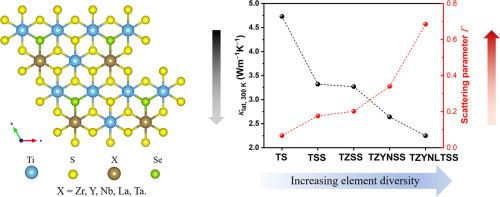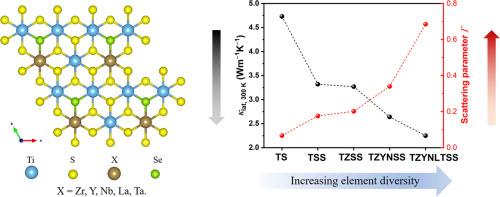实现六重掺杂 TiS2 的低导热性和高品质因数
IF 8.3
1区 材料科学
Q1 MATERIALS SCIENCE, MULTIDISCIPLINARY
引用次数: 0
摘要
过渡金属二钴化物 TiS2 因其价格低廉、无毒、环保和使用非关键元素而成为室温和中温热电材料的可持续候选材料。然而,TiS2 的轻元素组成特性导致其热导率较大,这是限制其热电性能的主要因素。在此,我们报告了一种多元素掺杂策略,即掺入等价(Se、Zr)元素,并成对引入高价(Nb、Ta)和低价(Y、La)元素,以最大限度地降低其晶格热导率κlatκlat。研究结果表明,在整个温度范围内,κlatκlat 下降了近 50%,这归因于多元素掺杂后出现了强烈的点缺陷散射。此外,我们还观察到在多元素掺杂的 TiS2 中,κlatκlat 对温度的依赖性降低,因为点缺陷在室温下可以有效地散射声子。因此,多元素掺杂 TiS2 在 625 K 时达到了约 0.4 的最高 ZT 值。将高价元素和低价元素成对掺杂在一起,证明是降低晶格热导率的有效方法,而不会过多地影响其大塞贝克系数。本文章由计算机程序翻译,如有差异,请以英文原文为准。


Achieving low thermal conductivity and high quality factor in sextuple-doped TiS2
Transition-metal dichalcogenide TiS2 stands out as a sustainable candidate for room- and medium-temperature thermoelectric materials due to its affordability, non-toxicity, eco-friendly nature and use of non-critical elements. However, its light element compositional nature results in a large thermal conductivity, which is the main limitation of the thermoelectric performance of TiS2. Here, we report a multi-element doping strategy by incorporating equivalent (Se, Zr) elements and introducing higher-valence (Nb, Ta) and lower-valence (Y, La) elements in pairs to minimize its lattice thermal conductivity, . The findings indicate a nearly 50 % decrease in across the entire temperature range, attributed to the presence of strong point-defect scattering after multi-element doping. Additionally, we observed a reduced dependency of on temperature in multi-element doped TiS2, as point defects can effectively scatter phonons at room temperature. As a result, the multi-element doped TiS2 attained its highest ZT value of approximately 0.4 at 625 K. Incorporating higher-valence and lower-valence elements in pairs proves to be an effective method for decreasing lattice thermal conductivity without compromising too much of its large Seebeck coefficient.
求助全文
通过发布文献求助,成功后即可免费获取论文全文。
去求助
来源期刊

Acta Materialia
工程技术-材料科学:综合
CiteScore
16.10
自引率
8.50%
发文量
801
审稿时长
53 days
期刊介绍:
Acta Materialia serves as a platform for publishing full-length, original papers and commissioned overviews that contribute to a profound understanding of the correlation between the processing, structure, and properties of inorganic materials. The journal seeks papers with high impact potential or those that significantly propel the field forward. The scope includes the atomic and molecular arrangements, chemical and electronic structures, and microstructure of materials, focusing on their mechanical or functional behavior across all length scales, including nanostructures.
 求助内容:
求助内容: 应助结果提醒方式:
应助结果提醒方式:


